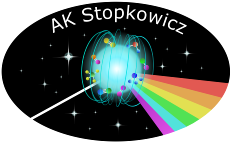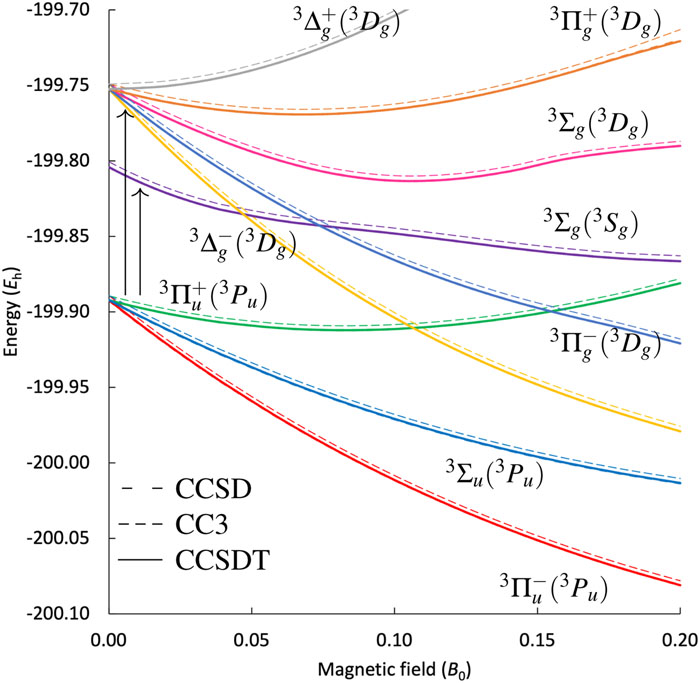News-Archiv
2024
The Approximate Coupled-Cluster Methods CC2 and CC3 in a Finite Magnetic Field
Veröffentlichung im Journal of Chemical Physics
Marios-Petros Kitsaras, Laura Grazioli, Stella Stopkowicz
In this paper, we report on the implementation of CC2 and CC3 in the context of molecules in finite magnetic fields. The methods are applied to the investigation of atoms and molecules through spectroscopic predictions and geometry optimizations for the study of the atmosphere of highly magnetized White Dwarf stars. We show that ground-state finite-field (ff) CC2 is a reasonable alternative to CCSD for energies and, in particular, for geometrical properties. For excited states, ff-CC2 is shown to perform well for states with predominant single-excitation character. Yet, for cases in which the excited state wavefunction has double-excitation character with respect to the reference, ff-CC2 can easily lead to completely unphysical results. Ff-CC3, however, is shown to reproduce the CCSDT behavior very well and enables the treatment of larger systems at a high accuracy.

MMQC Konferenz Mariapfarr
Vom 26.02. bis zum 29.02. ist unsere Gruppe nach Österreich auf der diesjährigen Konferenz für "Modern methods in quantum chemsitry" (MMQC) in Mariapfarr gefahren. Dort konnten wir uns mit anderen Arbeitsgruppen austauschen, verschiedene Vorträge anhören und unsere eigene Forschung vorstellen. Neben dem wissenschaftlichen Austausch konnten die Nachmittage genutzt werden um das angrenzende Skigebiet zu erkunden. Prof. Stella Stopkowicz, Dr. Marios-Petros Kitsaras und Laurenz Monzel haben verschiedene Vorträge über unsere Forschung und Entwicklung gehalten während Lukas Schank uns mit einem Poster in der Postersession vertreten hat.
Theoretical prediction of closed-shell paramagnetism for scandium and yttrium hydride
Veröffentlichung im Journal of Computational Chemistry
Laura Grazioli, Luca T. Schleicher, Stella Stopkowicz, Jürgen Gauss
Following chemical intuition, one would expect that all closed-shell molecules arediamagnetic. However, it is known that this is not the case for some second-rowhydrides with low-lying unoccupiedπorbitals due to an unquenching of the totalangular momentum in the presence of an external magnetic field. In this article, thetransition-metal hydrides ScH and YH are investigated, assuming a similar unquench-ing effect involving low-lying unoccupied π and δ orbitals formed from the metaldorbitals rather than theporbitals. We are comparing results obtained with variousquantum-chemical methods (HF, CCSD, CCSD(T), CCSDT) and basis sets. Theobtained positive values for the magnetizabilities clearly indicate paramagneticbehavior. Vibrational effects on the magnetizability tensor are also considered, butthese effects are small and do not change the overall conclusion that both ScH andYH are further examples for closed-shell paramagnetism.
2023
Magnetic Optical Rotation from Real-Time Simulations in Finite Magnetic Fields
Veröffentlichung im Journal of Chemical Physics
Benedicte Sverdrup Ofstad, Meilani Wibowo-Teale, Håkon Emil Kristiansen, Einar Aurbakken, Marios Petros Kitsaras, Øyvind Sigmundson Schøyen, Eirill Hauge, Simen Kvaal, Stella Stopkowicz, Andrew M. Wibowo-Teale, Thomas Bondo Pedersen
We present a numerical approach to magnetic optical rotation based on real-time time-dependent electronic-structure theory. Not relying on perturbation expansions in the magnetic field strength, the formulation allows us to test the range of validity of the linear relation between the rotation angle per unit path length and the magnetic field strength that was established empirically by Verdet 160 years ago. Results obtained from time-dependent coupled-cluster and time-dependent current density-functional theory are presented for the closed-shell molecules H2, HF, and CO in magnetic fields up to 55 kT at standard temperature and pressure conditions. We find that Verdet’s linearity remains valid up to roughly 10–20 kT, above which significant deviations from linearity are observed. Among the three current density-functional approximations tested in this work, the current-dependent Tao–Perdew–Staroverov–Scuseria hybrid functional performs the best in comparison with time-dependent coupled-cluster singles and doubles results for the magnetic optical rotation.

DFG bewilligt SFB 1633 "Elektronenverschiebung durch Protonen"
Gestern Abend bewilligte die DFG offiziell den neuen Sonderforschungsbereich (SFB) 1633 "Elektronenverschiebung durch Protonen – Vereinigende Strategien für die Mehrelektronenredoxkatalyse durch protonengekoppelten Elektronentransfer" neben 16 weiteren neuen SFB.
Nach langen und intensiven Vorbereitungen hatten die beteiligten PIs und Studierende den SFB in einem on-site review an der Georg-August-Universität Göttingen präsentiert und damit offenbar die Gutachter überzeugt. Der neue SFB 1633 befasst sich mit der Entwicklung neuer Konzepte und Strategien für die Katalyse mittels des Phänomens des Protonen-gekoppelten Elektronentransfers (PCET), wobei auch die fundamentalen mechanistischen Fragen zu den Reaktionen mit PCET aufgeklärt werden sollen.
Unsere Arbeitsgruppe ist im SFB mit einem Projekt in Kooperation mit den Universtäten Mainz und Göttingen vertreten und wird hochgenaue quantenchemische Berechnungen sowie Methoden zur Beschreibung der Natur der am PCET beteiligten elektronischen Zustände einbringen.
Christoph Harrer schließt erfolgreich seine Bachelorarbeit ab
Wir gratulieren Christoph Harrer zu seiner Bachelorarbeit mit dem Titel "Moleküle in Kavitäten in Gegenwart finiter magnetischer Felder". Die in der Arbeit vorgestellten Rechnungen analysieren die Auswirkungen einer Kavität auf die dispersive Wechselwirkung von kleinen Molekülen. Ein externes Magnetfeld diente hierbei als zusätzliche Stellschraube um Einfluss auf das System zu nehmen. In seiner Arbeit gelang es Christoph grundlegende Fragen zu beantworten wie Licht und Materie miteinander wechselwirken und wie sich ein Molekül im Regime der starken Kopplung verhält. Wir freuen uns ganz besonders, dass Christoph auch weiter als HiWi-Student in unserer Gruppe arbeiten wird.
Sommerschule - Modern Wavefunction Based Methods in Electronic Structure Theory
Alle Doktoranden aus unserer Gruppe haben die Gelegenheit genutzt an der diesjährigen MWM Summerschool in Pisa teilzunehmen. Dort konnten für eine Woche verschiedenen Vorlesungen besucht werden, die ein vertieftes Verständnis über wellenfunktionsbasierte Methoden in der Quantenmechanik vermittelten. Prof. Stella Stopkowicz hielt eine Vorlesung über Ableitungstheorie und ihrer Anwendung zur quantenchemischen Berechnung molekularer Eigenschaften mit einem Fokus auf magnetische Eigenschaften. Besonders freut uns auch, dass Post-Doc Marios-Petros Kitsaras uns als einer der Tutoren begleiten durfte und auf der Summerschool die teilnehmenden Studierenden in den Übungen betreute. Darüber hinaus hat jeder Doktorand unserer Gruppe ein Poster mitgebracht um in den Postersessions die eigene Forschung vorzustellen und sich in der Community auszutauschen.

Marios-Petros Kitsaras verteidigt erfolgreich seine Doktorarbeit
Wir gratulieren Marios-Petros Kitsaras zur erfolgreichen Verteidigung seiner Doktorarbeit mit dem Titel "Finite magnetic-field Coupled Cluster methods: Efficiency and Utilities". Die in der Arbeit vorgestellten Methoden ermöglichten es erstmals die Existenz von Metallen in der Atmosphäre von stark magnetisch Weißen Zwergen spektroskopisch zu verifizieren und hochgenaue Vorhersagen für chemische Bindungen in Gegenwart von sehr starken Magnetfeldern zu treffen.
Die Arbeit wurde der Johannes-Gutenberg Universität Mainz vorgelegt.

Neue Mitarbeiterin
Wir heißen unser neustes Gruppenmitglied willkommen, unsere Siebträgermaschine Marchesa. Sie konnte sich in einer intensiven Testphase durch ihre hervoragenden Crema behaupten und wird unsere Arbeitsgruppe von heute an begleiten. Wir wünschen Ihr viel Erfolg dabei, diese und die kommenden Generationen zuverlässig mit Kaffee zu versorgen.

Söllerhaus Seminar
Vom 22. Juli bis 26. Juli sind die Theoretischen Chemie Arbeitskreise von den Universitäten Karlsruhe, Mainz, Stuttgart und Saarbrücken zu einem gemeinsamen Seminar ins Kleinwalsertal gefahren. Für vier Tage konnten an den Vormittagen kleinere Wandertouren bestritten werden, während die Nachmittage und Abende ganz dem wissenschaftlichen Austausch gewidmet waren. Alle teilnehmenden Doktoranden haben dazu einen Vortrag über ihren aktuelle Forschung vorbereitet welcher im Plenum vorgetragen und diskutiert wurde. Besonders hat uns gefreut, dass Prof. Wim Klopper aus Karlsruhe ein Tutorium über die Nützlichkeit von Greenschen-Funktionen in der Chemie gehalten hat.
Wir freuen uns schon auf nächstes Jahr!

ICQC Konferenz in Bratislava
Mit vier Postern (Marios-Petros Kitsaras, Laura Grazioli, Jeremias Oswald und Laurenz Monzel) und einem Vortrag (Prof. Stella Stopkowicz) ist unsere Arbeitsgruppe zur diesjährigen "International Conference of Quantum Chemsitry" (ICQC) nach Bratislava aufgebrochen. Für sechs Tage konnten wir an verschieden Vorträgen teilnehmen, die aktuelle Fragen aus der Theoretischen Chemie diskutierten, andere Arbeitsgruppen treffen und mit einem eingeladenen Vortrag "Advances and challanges in the study of atoms and molecules in (strong) magnetic fields" einen Einblick in unsere Forschung geben. Ganz besonders freut uns, dass Laura Grazioli mit ihrem Poster "From Magnetic Circular Dichroism to Magnetic White Dwarfs: Challenges in the Calculation of Properties in a Magnetic Field, using Coupled-Cluster and Unitary Coupled-Cluster Theory" einen Posterpreis gewinnen konnte.

Teilnahme an dm-Firmenlauf für die UdS
Am Freitag, dem 16. Juni, war ein Teil unserer Gruppe beim dm-Firmenlauf in der Innenstadt von Saarbrücken dabei. Trotz der sommerlichen Temperaturen haben alle ihr Bestes gegeben und so persönliche Bestleistungen erzielt. Dadurch konnten wir auch einen Beitrag zum Sieg der UdS im Firmenranking leisten.
Another Torture Track for Quantum Chemistry: Reinvestigation of the Benzaldehyde Amidation by Nitrogen-Atom Transfer from Platinum(II) and Palladium(II) Metallonitrenes
Veröffentlichung in "Israel Journal of Chemistry"
H. Verplancke, M. Diefenbach, J. N. Lienert, M. Ugandi, M.-P. Kitsaras, M. Roemelt, S. Stopkowicz and M. C. Holthausen
We showcase here a dramatic failure of CCSD(T) theory that originates from the pronounced multi-reference character of a key intermediate formed in the benzaldehyde amidation by N-atom transfer from Pd(II) and Pt(II) metallonitrenes studied recently in combined experimental and theoretical work. For detailed analysis we devised a minimal model system, for which we established reliable reference energies based on approximate full configuration interaction theory, to assess the performance of single-reference coupled-cluster theory up to the CCSDTQ(P) excitation level. While RHF-based CCSD(T) theory suffered dramatic errors, in one case exceeding 220 kcal mol−1, we show that the use of broken-symmetry (BS) or Kohn-Sham (KS) orbital references yields substantially improved CCSD(T) results. Further, the EOM-SF-CCSD(T)(a)* approach met the reference data with excellent accuracy. We applied the KS-CCSD(T*)-F12b variant as high-level part of an ONIOM(KS-CC:DFT) scheme to reinvestigate the reactivity of the full Pt(II) and Pd(II) metallonitrenes. The revised reaction pathway energetics provide a detailed mechanistic rationale for the experimental observations.
A DZ white dwarf with a 30 MG magnetic field
Veröffentlichung in "Monthly Notices of the Royal Astronomical Society"
M. A. Hollands, S. Stopkowicz, M.-P. Kitsaras, F. Hampe, S. Blaschke and J.J. Hermes
Magnetic white dwarfs with field strengths below 10 MG are easy to recognise since the Zeeman splitting of spectral lines appears proportional to the magnetic field strength. For fields ≳ 100 MG, however, transition wavelengths become chaotic, requiring quantum-chemical predictions of wavelengths and oscillator strengths with a non-perturbative treatment of the magnetic field. While highly accurate calculations have previously been performed for hydrogen and helium, the variational techniques employed become computationally intractable for systems with more than three to four electrons. Modern computational techniques, such as finite-field coupled-cluster theory, allow the calculation of many-electron systems in arbitrarily strong magnetic fields. Because around 25 percent of white dwarfs have metal lines in their spectra, and some of those are also magnetic, the possibility arises for some metals to be observed in very strong magnetic fields, resulting in unrecognisable spectra. We have identified SDSS J114333.48+661531.83 as a magnetic DZ white dwarf, with a spectrum exhibiting many unusually shaped lines at unknown wavelengths. Using atomic data calculated from computational finite-field coupled-cluster methods, we have identified some of these lines arising from Na, Mg, and Ca. Surprisingly, we find a relatively low field strength of 30 MG, where the large number of overlapping lines from different elements make the spectrum challenging to interpret at a much lower field strength than for DAs and DBs. Finally we model the field structure of SDSS J1143+6615 finding the data are consistent with an offset dipole.
2022
Trendbericht Theoretische Chemie 2022: Quantenchemie für Atome und Moleküle in starken Magnetfeldern
Veröffentlichung in "Nachrichten aus der Chemie"
Maschinelles Lernen eignet sich, um Photochemie und somit elektronisch angeregte Zustände zu beschreiben; klassische Molekulardynamiktechniken erlauben, bestimmte Aspekte der nuklearen Quanteneffekte in Probleme der physikalischen Chemie einzubeziehen, und was Finite-Feld-Methoden mit alten Sternen zu tun haben.



